When it comes to the techniques of inflicting pain on people in a way that is both cruel and spectacular, the imaginations of the ancient Romans knew no bounds. They simply competed in ideas for making a human blood pulp as creatively as possible. To the glory of Caesar and the delight of the crowd. But also as a warning.
In the 5th century BC, the sixth king of Rome, Servius Tulius, separated civil and criminal offenses, and limited the death penalty to the most serious crimes. Assault and robbery were usually punished with a heavy fine, although sometimes they were hanged for stealing crops. No torture was given to priests, children under fourteen or pregnant.
Everything has changed since the times of Julius Caesar, who paved the way for a multitude of rulers, to put it mildly - unpleasant. After Caesar's murder, Marcus Antony, Octavius Caesar and Marcus Emilius Lepidus took power. They did not trust each other, they ventilated conspiracies everywhere. Torture flourished in an atmosphere of terror and paranoia , and successive rulers competed in ideas for inflicting torture.
A legionnaire under the bat of a commander
The first group to fall under the tyrants' shoes were soldiers. After all, it was Caesar's legions who had overthrown the old republic, so now it was necessary to make sure that their ambition did not get too wild. During the imperial era, it became clear that a legionnaire should fear his commanders more than his foe.
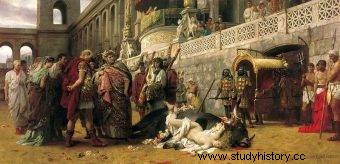
The fate of Christians during the persecution was especially remembered by the Romans. The cruelty of the ancients captured the imaginations of 19th-century artists. Henryk Siemiradzki, "Christian Dirce" (source:public domain).
The lashings were the most common, but the Romans were able to make a simple whip into a versatile torture device. Mild offenses punished with flogging with a leather whip, more serious offenses were punished with a flagrum ended with metal balls and hooks . According to tradition, Jesus Christ was scourged by him. However, an emperor found flogging too lenient.
Flogging is not enough for a butcher
Emperor Macrinus was such a sadist that his slaves called him "the butcher" because the walls of his house ran with blood . Arrogant and bloodthirsty, he crucified his own soldiers for just offenses and humiliated the punishments customarily imposed on slaves.
When he discovered that several of his soldiers were sleeping with the same maid, ordered two large oxen to be cut open and had them sewn up in the bellies of the animals so that their heads protruded outwards . He wanted them to be able to talk to each other while dying. His biographer commented that such punishments were not even imposed for adultery, neither in our ancestral times, nor today . Macrinus had his own punishment for this "crime": the couple were tied together and burned alive . He also liked to be skinned.
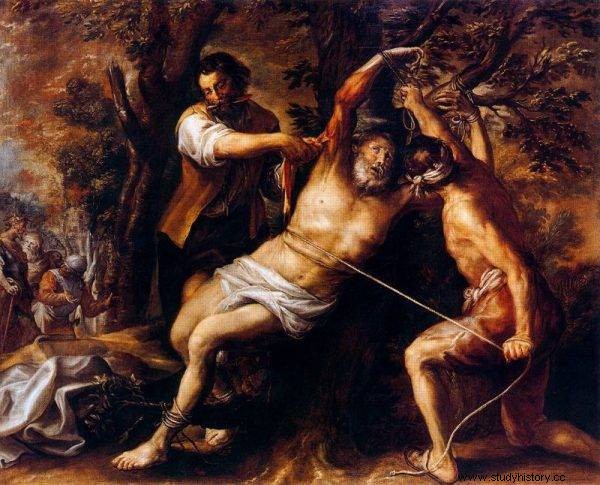
Peeling skin was a particularly cruel form of punishment. Francisco Camilo, "The Skin Ripping of St. Bartholomew "(source:public domain).
The cruel emperor also restored the ancient torture of the Etruscan tyrant Mesentius. The victim was tied to a corpse and left for death consumed by slow decay . He had no mercy even towards his own soldiers. In the face of rebellion, he decimated the army, murdering one in ten (the so-called decimation). He murdered one in a hundred for complaining, and considered it a sign of mercy.
He was not the only emperor who liked the murder of legionnaires - during the reigns of Diocletian and Maximian, about six thousand soldiers from the Theban Legion were decimated, who were martyred for their faith.
Necessity is the mother of invention
The Romans were creative people. Their engineers were famous throughout the ancient world, and many of their road-building devices and siege tools were perfect for torture.
With the help of an ordinary pulley hoist, it was possible to suspend a person high above the ground, and then suddenly lower it down. Sometimes the victim was lowered onto sharp stones so many times that the body turned into a bloody pulp .
The lifts were also used to break the limbs out of the joints or tear the body apart . All these devices and torture, however, were not used to execute, but to obtain testimony from suspects, and sometimes even witnesses. Seneca thought torture was cruel and unhelpful in obtaining evidence, but he was in the minority.
Break, grind, bake
One of the most terrible torture devices used by the Romans, which became popular in the centuries that followed, was the wheel. Unlike the Greek version, which usually resembled a wagon wheel, the Roman version looked more like a drum. In one variant, the victim was tied to the rim of the wheel and dropped down the slope.
In another wheel on an axis, a fire was placed over the fire, and the victim was broken and roasted while alive. Yet another version of torture with a wheel involved placing skewers on it, and others under the wheel. The rotating victim was literally ground to pieces.
The enemies of the state - on the cross
The Romans invented many tortures, some of which were forgotten and others became too popular. The former include sewing up parricides in a canvas bag with poisonous snakes . If the victim survived the bites, he would die by drowning in the nearest body of water anyway.
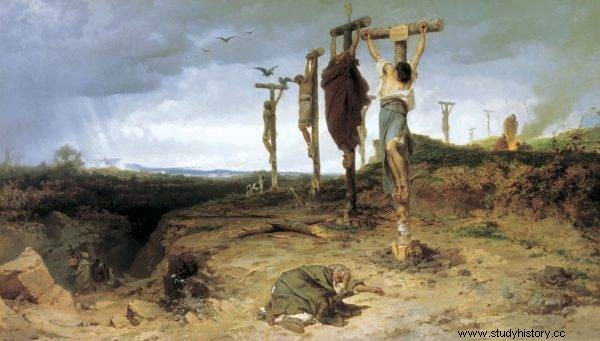
The Roman commander Crassus crucified 6,000 supporters of Spartacus. The crosses were lined up along the road between Rome and Capua. Fyodor Andreevich Bronnikov, "Crucified Slaves" (source:public domain).
The second group includes crucifixion, which was applied to slaves already in the late republic. Only the emperors began to crucify other convicts as well. The death on the cross was slow and painful, but also very show because many people were often crucified at once. It has become the favorite method of getting rid of the "enemies of the state."
With time, both recalcitrant Jews from Palestine and troublesome Christians, of whom more and more appeared in the empire in the second and third centuries, hung on the crosses. During the reign of Vespasian, when General Titus besieged Jerusalem in AD 70, 500 Jews were crucified daily.
After the bad mister…
The reign of the misanthrope-paranoid Tiberius in the first half of the first century was marked by terror and hatred. He spent his last years in Capri, where killed time inventing torture and executions for prisoners captured and taken to the island even without trial. He appointed the mad Gaius Caesar, who went down in history as Caligula, to succeed him.
Like his uncle, he liked to torture people in an intimate setting so he would do it in the party room, for example. Caligula ordered his torturers to strike the victim in such a way that it felt that he was dying. The high born were branded in their faces, caged or cut in half.
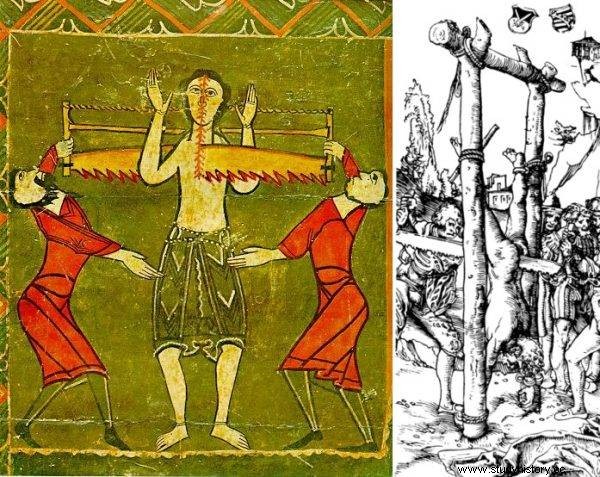
cutting people off must have been a macabre spectacle (source:public domain).
When an actor was asked who was more powerful:the king of the gods Jupiter or Caligula, and he hesitated when answering, the mad emperor ordered him to be beaten with a whip until his body fell to pieces .
He listened to pleas for mercy with delight, praising the timbre of the victim's voice. He ordered a certain senator to cut open his abdomen and to gouge out his eyes and internal organs with hot tweezers so that he would die longer. Then it was sawn in half.
Christians like fried fish
Fortunately, Caligula was murdered after four years of rule, and his successor, Claudius, tried unsuccessfully to restore order in the country. Poisoned by his wife, he made way for stupid, spoiled and vain Nero.
When a fire broke out in Rome in July 64 and the emperor learned of the arson charges, he looked for a scapegoat. It fell on the Christians, against whom he ordered a terrible purge. The chronicler Haban Maur wrote: They were pierced with a sword, burned, tortured with a whip, crucified, drowned in the sea, skinned, their tongues cut off, stoned, their hands cut off or dismembered.
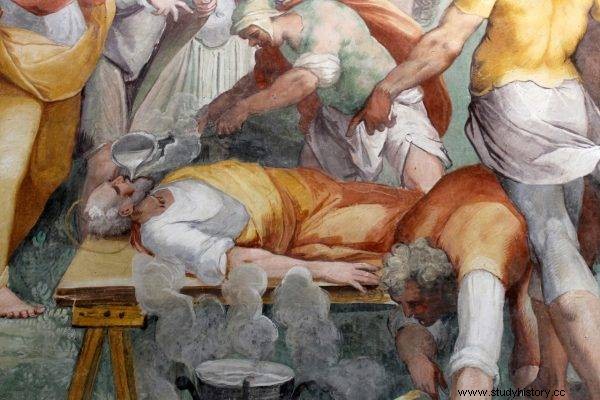
The Romans forced Saint Primus to drink dissolved lead. Niccolò Circignani known as il Pomarancio, "The Martyrdom of St. Prymusa ”(author:Alkjds, license:CC BY-SA 4.0).
Nero had Christians put on animal skins and throw a pack of dogs, sent them unarmed against gladiators, hung them by their thumbs and simmered and skinned them.
Some were squashed in grape presses, others were put on red-hot chain mail, still others were impaled or their bellies cut open and left to be eaten by wild animals. At night, the burning piles served as lighting. He outdid himself when he decided to fry Christians like fish :
A frying pan was filled with oil, tar or resin, then put on a fire, and when the liquid began to bubble, Christians were thrown into it, insisting on their faith to fry like fish .
Even the historian Tacitus, who was not very favorable to Christians, wrote that they were sentenced to death only to satisfy one person's bloodlust.
Death in the bronze bull
One Roman torture, however, beats all others with cruelty and creativity. We are talking about the bronze bull torture, invented in the 6th century BC by the Athenian artist Perillus. The victim was placed in an empty bull's belly, and the scream was distorted by an ingeniously constructed modulator and sounded like an animal's roar.
According to the historian of Diodorus Siculus, the inventor showed the bull to Falaris, the tyrant of Akragas in Sicily. The tyrant was impressed, but before presenting the award, he asked Perillus to enter the bull and fake the screams of the dying man. At that time, the door was closed and the fire was set.
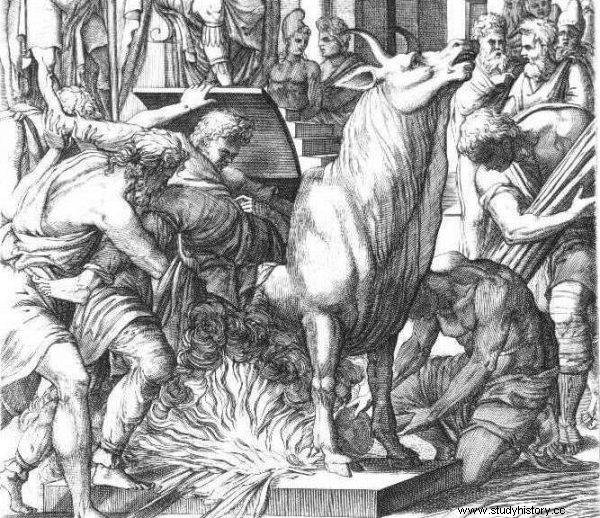
Pierre Woeiriot, "The Bronze Bull" (source:public domain).
Falaris liked the "bullish" screams, so he ordered the inventor still alive to be brought out so as not to spoil his new toy, then he was appreciated by throwing him off the cliff. The tyrant's subjects were less pleased - at the sight of a new method of public executions, they rebelled and overthrew him. His tongue was ripped out and then roasted alive in a bull.
Unfortunately, the idea caught on and several Christian martyrs died that way, including St. Roman Eustace and St. Antipas of Pergamon. Dante immortalized this terrible torture in the Divine Comedy .
Bibliography:
- N. Cawthorne, Public Executions:From Ancient Rome to the Present Day , Chartwell Books 2006
- M.P. Donelly, D. Diehl, The Big Book of Pain. Torture and punishment through history , History Press 2008
- J. Kellaway, A History of Torture and Execution , crowd. E. Ressel, Elipsa 2009
- A. Ziółkowski, Universal history. Antiquity , Polish Scientific Publishers PWN, 2009
